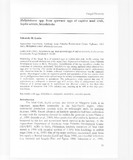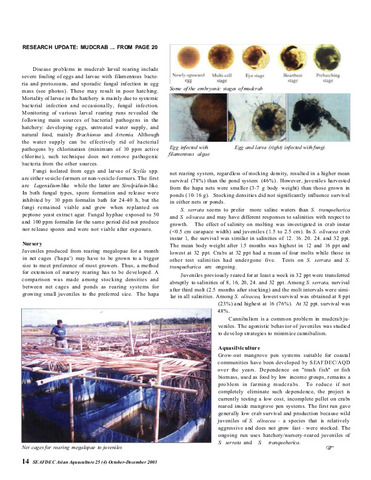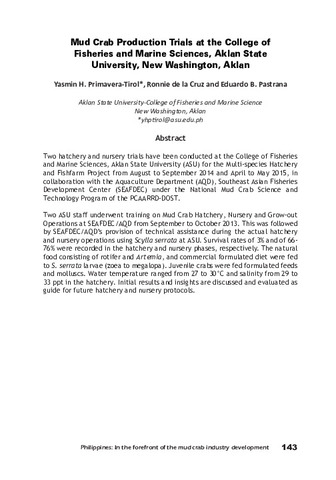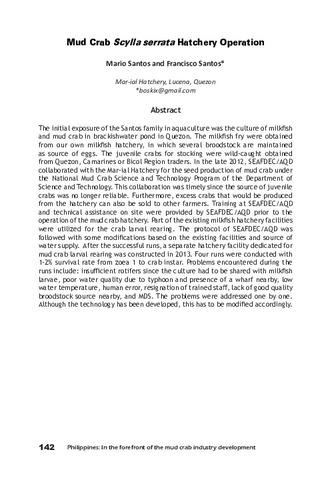Haliphthoros spp. from spawned eggs of captive mud crab, Scylla serrata, broodstocks

Associated URL
www.fungaldiversity.orgDate
2002Author
Page views
429Metadata
Show full item record
Share
Abstract
Monitoring of the fungal flora of spawned eggs of captive mud crab, Scylla serrata, was conducted in several hatchery runs at the Aquaculture Department of Southeast Asian Fisheries Development Center in Iloilo, Philippines. Quantification of the egg mycoflora revealed the dominance of oomycetes, particularly Haliphthoros spp. among spawners which aborted their eggs prior to hatching. Two species of Haliphthoros (H. philippinensis and H. milfordensis) were identified from the 24 isolates collected. Haliphthoros milfordensis was the dominant species. Physiological studies on vegetative growth and sporulation of the two species show that H. philippinensis have wider optimal range for salinity and temperature requirements than H. milfordensis, especially in sporulation. The pathogenicity study showed that only H. milfordensis was pathogenic to spawned eggs of S. serrata, while H. philippinensis was not. Infection of S. serrata eggs by H. milfordensis was observed starting at two days after inoculation of zoospores with 2-5% infection rate, reaching up to 10% at five days post-inoculation.
Suggested Citation
Leaño, E. M. (2002). Haliphthoros spp. from spawned eggs of captive mud crab, Scylla serrata, broodstocks. Fungal Diversity , 9, 93-103. http://hdl.handle.net/10862/1938
Subject
Taxonomic term
Collections
- AQD Journal Articles [1249]
Related items
Showing items related by title, author, creator and subject.
-
European Union's special project on mudcrab
Castaños, Milagros T.; Southeast Asian Fisheries Development Center, Aquaculture Department (Aquaculture Department, Southeast Asian Fisheries Development Center, 2003) -
Mud crab production trials at the College of Fisheries and Marine Sciences, Aklan State University, New Washington, Aklan
Primavera-Tirol, Yasmin H.; de la Cruz, Ronnie; Pastrana, Eduardo B. (Aquaculture Department, Southeast Asian Fisheries Development Center, 2017)Two hatchery and nursery trials have been conducted at the College of Fisheries and Marine Sciences, Aklan State University (ASU) for the Multi-species Hatchery and Fishfarm Project from August to September 2014 and April ... -
Mud crab Scylla serrata hatchery operation
Santos, Mario; Santos, Francisco (Aquaculture Department, Southeast Asian Fisheries Development Center, 2017)The initial exposure of the Santos family in aquaculture was the culture of milkfish (Chanos chanos) and mud crab (Scylla serrata) in brackishwater pond in Quezon. The milkfish fry were obtained from our own milkfish ...



